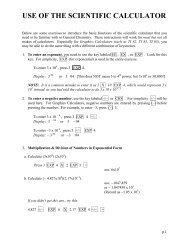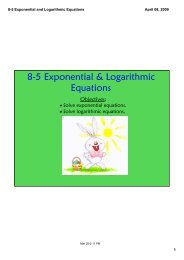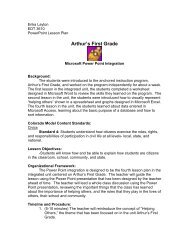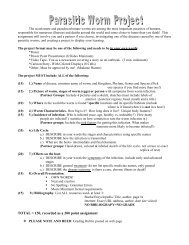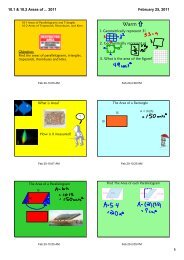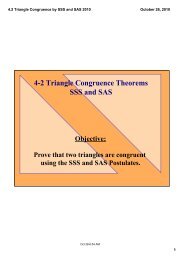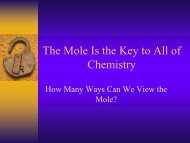Stoichiometry PowerPoint
Stoichiometry PowerPoint
Stoichiometry PowerPoint
Create successful ePaper yourself
Turn your PDF publications into a flip-book with our unique Google optimized e-Paper software.
<strong>Stoichiometry</strong><br />
Connecting Mathematics to Balanced<br />
Chemical Equations
Balanced Equations<br />
• You already have experience balancing<br />
equations. We have used this simple one<br />
for the formation of water before.<br />
<br />
• 2H 2 + O 2 2 H 2 O
Understanding <strong>Stoichiometry</strong><br />
• Hydrogen atoms are tiny, with a mass of<br />
only 1 amu per atom, and 2 amu per<br />
molecule. Oxygen atoms are much larger.<br />
1 1 1<br />
• 1 H atom<br />
1 H 2 molecule<br />
16<br />
• O atom<br />
16 16<br />
O 2 molecule
Understanding <strong>Stoichiometry</strong><br />
• The trick to understanding stoichiometry is<br />
to realize that the ratio of the parts (atoms or<br />
molecules) is NOT the same as the ratio of<br />
the masses of the parts. In our example,<br />
reactant and product parts occur in a 2:1:2<br />
ratio; 2 hydrogen molecules and 1 oxygen<br />
molecule make 2 water molecules.
Understanding <strong>Stoichiometry</strong><br />
• However, the ratio of the masses is<br />
definitely NOT 2:1:2 because H and O<br />
atoms have very different masses. What is<br />
the mass ratio for this reaction?<br />
1<br />
1<br />
1<br />
1<br />
16 16<br />
<br />
1<br />
1 1<br />
1<br />
16<br />
16
Understanding <strong>Stoichiometry</strong><br />
• If you said 4 amu H 2 : 32 amu O 2 : 36 amu<br />
H 2 O, you are correct.<br />
1<br />
1<br />
1<br />
1<br />
16 16<br />
<br />
1<br />
1 1<br />
1<br />
16<br />
16<br />
• On a more practical level, we can also say<br />
that 4 g H 2 and 32 g O 2 give 36 g H 2 O.
The Magic of Avogadro’s<br />
Number<br />
• Remember what you learned earlier about<br />
Avogadro’s magical number. Our way of<br />
counting atoms and molecules is to take<br />
their masses on the atomic level (amu) and<br />
translate them directly into grams. The<br />
gram atomic or gram molecular mass of an<br />
element or compound = 1 mole of that<br />
substance or 6.02 x 10 23 particles.
Conservation of Mass<br />
• Remember also that atoms and molecules<br />
cannot appear or disappear, so the total<br />
masses of all the reactants must equal the<br />
total masses of all the products.<br />
• 4g H 2 + 32g O 2 36g H 2 O<br />
• 36 g reactants 36g products
Conservation of Mass<br />
• All of the atoms present at the start are still present<br />
at the end; they have simply been rearranged into<br />
new combinations.<br />
• It’s sort of like the world’s coolest Lego set. You<br />
have some basic building blocks, and you can<br />
make all sorts of great stuff.<br />
• This is true for all chemical reactions and<br />
processes.<br />
Formative assessment: Unit 9, 5 clicker questions.
Other Examples<br />
• Remember this drawing?<br />
1<br />
1<br />
1<br />
1<br />
16 16<br />
<br />
1<br />
1 1<br />
1<br />
16<br />
16<br />
• Can you make a similar drawing for the<br />
reaction: Mg + F 2 MgF 2 ?<br />
• What are the particle and mass ratios for<br />
this reaction?
Mg + F 2 MgF 2<br />
• Did your drawing look like this?<br />
• 24.3 19 19<br />
19 24.3 19<br />
•Particle ratio: 1:1:1<br />
•Mass ratio: 24.3amu : 38.0amu : 62.3amu<br />
•Or 24.3g : 38.0g : 62.3g
Other Examples<br />
• Try this one. Again, use a diagram to<br />
determine particle and mass ratios.<br />
• 4 Al + 3 O 2 2 Al 2 O 3<br />
27<br />
27<br />
16 16<br />
<br />
16<br />
27<br />
16<br />
27<br />
16<br />
27<br />
27<br />
16 16<br />
16 16<br />
16<br />
27<br />
16<br />
27<br />
16
4 Al + 3 O 2 2 Al 2 O 3<br />
• Particle ratio: 4 : 3 : 2<br />
• Mass ratio: 108amu : 96amu : 204amu<br />
• Or 108g : 96g : 204 g<br />
(4 mol : 3 mol : 2 mol)
Balanced Equation Coefficients<br />
• By now you have noticed that the ratio of<br />
the particles is the same as the coefficients<br />
in the balanced equation.<br />
• The coefficients in any balanced chemical<br />
equation represent both particles and moles<br />
of the substances in the reaction.
Mass Ratios<br />
• Determining mass ratios without pictures is<br />
a simple matter of converting moles to<br />
grams.<br />
• From the 4 Al + 3 O 2 2 Al 2 O 3 example,<br />
the math looks like this:<br />
• 4 mol Al x (27.0g/mol) = 108g Al<br />
• 3 mol O 2 x (32g/mol) = 96g O 2<br />
• 2 mol Al 2 O 3 x (102g/mol) = 204g Al 2 O 3
Now The Fun Begins<br />
• Solving stoichiometry problems is easy if<br />
you know<br />
• The mole ratio of the reactants and<br />
products from the balanced equation<br />
and<br />
• The molar mass of each reactant and<br />
product.
Now The Fun Begins<br />
• Once you know these 2 things, you<br />
can be given a starting amount of any<br />
material in the problem and calculate<br />
how much of everything else will be<br />
needed or produced.
Looking Back<br />
• If we go back to our first example:<br />
1<br />
1<br />
1<br />
1<br />
16 16<br />
<br />
1<br />
1 1<br />
1<br />
16<br />
16<br />
• What if there were 6 H 2 molecules (or moles)<br />
rather than 2? How many O 2 molecules (or<br />
moles) would be required, and how many water<br />
molecules (or moles) could we make?
Mole Ratio<br />
• Three times as much hydrogen requires 3<br />
times as much oxygen. 3 molecules or<br />
moles of oxygen are required.<br />
• Also 3 times as much water will be<br />
produced. 6 molecules or moles of water.<br />
• 6 H 2 + 3 O 2 6 H 2 O<br />
• Notice that the mole ratio (2:1:2) from the<br />
balanced equation has been maintained.
Masses Involved<br />
• What will be the mass of 6 mol of H 2 ?<br />
• 6 mol (2.0g/mol) = 12g H 2<br />
• According to our picture, for every 4g of<br />
H 2 , 32g of O 2 are required. We need 3<br />
times as much oxygen: 3 x 32g = 96g O 2<br />
needed.<br />
• The original reaction made 36g of water, so<br />
starting with 6g of hydrogen makes 108g<br />
H 2 O (3 times as much.)
Solving <strong>Stoichiometry</strong> Problems<br />
• The heart of every stoichiometry problem is<br />
the ratio of moles from the balanced<br />
equation.<br />
• The number of moles of any material in the<br />
problem determines how many moles of<br />
everything else there will be.
Mole Ratios<br />
• If we use our basic water example again:<br />
• 2H 2 + O 2 2 H 2 O<br />
• If we start with 16 moles of Hydrogen we<br />
need 8 moles of oxygen and make 16 moles<br />
of water.<br />
• If we start with 0.0018 moles of hydrogen,<br />
we need 0.0009 moles of oxygen and make<br />
0.0018 moles of water.
Solving <strong>Stoichiometry</strong> Problems<br />
• Once you understand that relationship, the<br />
rest of the stoichiometry problem is easy.<br />
• Chemists don’t measure moles directly.<br />
They generally measure grams for solids,<br />
liters (of volume) for gases and mL or L for<br />
solutions. (We will deal with solutions<br />
later.)<br />
• Sometimes # of molecules will be involved.
Solving <strong>Stoichiometry</strong> Problems<br />
• So solving stoichiometry problems involves<br />
converting between these starting units to<br />
moles, and then from moles back to the<br />
units required at the end (mole map stuff.)<br />
• The typical sequence looks like this:<br />
• Amount known mol known <br />
mol unknown amount unknown<br />
• Each arrow represents a calculation.
Solving <strong>Stoichiometry</strong> Problems<br />
• Remember the screws, nuts and washers?<br />
• This is exactly the same kind of problem.<br />
• Grams of screws/mass of 1 screw = # screws.<br />
• # screws x 1 = # of nuts<br />
• # nuts x mass of 1 nut = g of nuts OR<br />
• # screws x 2 = # of washers<br />
• # washers x mass or 1 washer = g of washers.
Solving <strong>Stoichiometry</strong> Problems<br />
• For chemical problems:<br />
• g of Known Substance ÷ mass of 1 mole =<br />
moles of Known Substance<br />
• Use moles of Known Substance and ratio<br />
from equation to get moles of Unknown<br />
Substance.<br />
• Moles Unknown Substance x mass of 1<br />
mole = g of Substance 2.
Examples<br />
• Let’s try a couple of full-blown stoichiometry<br />
problems, but we will start simple.<br />
• CH 4 + O 2 CO 2 + H 2 O<br />
• First, balance the equation.<br />
• CH 4 + 2 O 2 CO 2 + 2 H 2 O<br />
• What is the mole ratio of the reactants and<br />
products?<br />
• 1:2:1:2
Examples<br />
• Next, calculate the molar masses of each<br />
material.<br />
• CH 4 = 16.0 g/mol<br />
• O 2 = 32.0 g/mol<br />
• CO 2 = 44.0 g/mol<br />
• H 2 O = 18.0 g/mol
Examples<br />
• If we start with 50.0grams of methane, how<br />
many grams of oxygen will be required? These<br />
problems are as easy as 1, 2, 3.<br />
• 1. Convert grams methane to moles.<br />
• 50.0g x (1 mol CH 4 /16.0g) = 3.12 mol CH 4<br />
• 2. Convert mol of methane to mol of oxygen.<br />
• 3.12 mol CH 4 x (2 mol O 2 /1 mol CH 4 ) = 6.24 mol O 2<br />
• 3. Convert mol O 2 to grams.<br />
• 6.24 mol O 2 x (32.0g O 2 /mol) = 200. g O 2
Examples<br />
• If we start with 50.0grams of methane, how many<br />
grams of water will be produced?<br />
• Again the procedure is the same.<br />
• 50.0g CH 4 x (1 mol/16.0g) = 3.12 mol CH 4<br />
• 3.12 mol CH 4 x (2 mol H 2 O/1 mol CH 4 ) = 6.24 mol H 2 O<br />
• 6.24 mol H 2 O x (18.0g/1 mol) = 112 g H 2 O<br />
• The 3-step sequence is the same:<br />
• gknown mol known mol unknown g unknown
Curve Ball<br />
• Starting with the same 50.0g of CH 4 , how<br />
many liters of CO 2 gas at STP will be<br />
produced?<br />
• The problem starts out just the same as<br />
before: Convert g known to moles.<br />
• 50.0g CH 4 x (1 mol/16.0g) = 3.12 mol CH 4<br />
• Next, use the mole ratio from the equation to<br />
convert mols known to mols unknown.<br />
• 3.12 mol CH 4 x (1 mol CO 2 /1 mol CH 4 ) = 3.12<br />
mol CO 2
Curve Ball<br />
• The last step is just a little different.<br />
• This time, we were not asked for grams of<br />
CO 2 , but for liters of gas.<br />
• We simply need to adjust the last<br />
calculation a little. Do you remember how<br />
many liters of gas at STP are in a mole?<br />
• 3.12 mol CO 2 x (22.4L/1 mol) = 69.9 L
Try One on Your Own<br />
• Fe 2 O 3 + 3 CO(g) 2 Fe + 3 CO 2<br />
• How many grams of Fe 2 O 3 will be needed to<br />
make 10.0g of Fe?<br />
• 10.0g Fe (1 mol/55.8g) = 0.179 mol Fe<br />
• 0.179 mol Fe (1 mol Fe 2 O 3 /2 mol Fe) =<br />
0.0895 mol Fe 2 O 3<br />
• 0.0895 mol Fe 2 O 3 (159.6g/mol) = 14.3g Fe 2 O 3
Try One on Your Own<br />
• How many liters of CO gas will be required<br />
to make the same 10.0g of Fe?<br />
• 10.0g Fe (1 mol/55.8g) = 0.179 mol Fe<br />
• 0.179 mol Fe (3 mol CO/2 mol Fe) = 0.268<br />
mole CO<br />
• 0.268 mol CO (22.4 L/mol) = 6.00 L of CO
Simplify<br />
• As you become more practiced at the 3 step<br />
stoichiometry problems, you can combine<br />
all the steps into 1 equation.<br />
• The last problem looks like this:<br />
• 10.0g Fe 1 mol Fe 3 mol CO 22.4 L CO =<br />
55.8 g Fe 2 mol Fe 1 mol CO<br />
• 6.00 L CO
Simplify<br />
• 10.0g Fe 1 mol Fe 3 mol CO 22.4 L CO =<br />
55.8 g Fe 2 mol Fe 1 mol CO<br />
• All three steps are here:<br />
• 1. Convert g mol of known<br />
• 2. Convert mol known mol unknown<br />
with ratio from equation.<br />
• 3. Convert mol unknown liters of<br />
unknown



